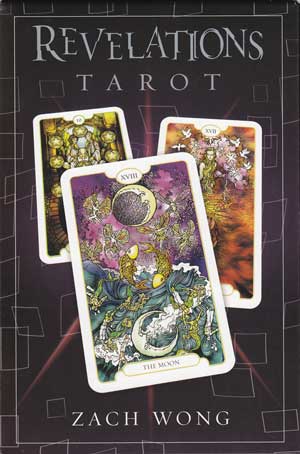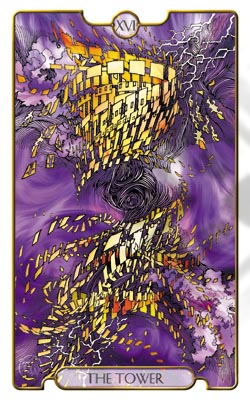When laying Tarot cards into a spread, a different interpretation is sometimes given to cards turning up ‘reversed’ or up-side-down. People give inverted cards an opposing interpretation to an upright one, or they say the impact of the card’s usual meaning is lessened. Not all Tarot readers use ‘reversed’ interpretations, some make sure all cards are placed upright and give interpretations according to the basic nature of each card. But if you like using reversed interpretations, you’ll love the concept devised by Australian deck creator Zach Wong.
 Llewellyn Publishers have just produced his Revelations Tarot Deck and I was fortunate enough to catch up with Zach recently. In this deck Zach has presented different symbolism on the bottom part of each card, so the inverted image is easily interpreted. These cards are based on the traditional Rider-Waite images, but he has blended them with his own unique, quirky, and colourful style. Here’s my interview with him…
Llewellyn Publishers have just produced his Revelations Tarot Deck and I was fortunate enough to catch up with Zach recently. In this deck Zach has presented different symbolism on the bottom part of each card, so the inverted image is easily interpreted. These cards are based on the traditional Rider-Waite images, but he has blended them with his own unique, quirky, and colourful style. Here’s my interview with him…
Mister Tarot: What motivated you to create your own Tarot designs?
Zach Wong: My interest in Tarot originated as an attraction to the art present within the medium. From a young age, I explored the imagery associated with it, by copying the art of various decks which were published in books. As I grew older I found myself at odds with the existing decks available in the late 1990s. While some of them were aesthetically stunning, they failed to resonate within me. Eventually, after graduating from architecture and running away from home, I found a lot of time on my hands to explore Tarot with less distractions. After revisiting my previously mentioned frustrations, I decided the only logical thing to do was to create my own deck. The reasoning seemed fair: it would have a personal connection and it would give me a canvas to explore the symbology as well as introduce aspects which were important to myself. The important thing to note though, is that from my exploration of decks online, and various publishing catalogues, there was an obvious lack of decks which had imagery for the reversals. I decided my deck would incorporate reversed images, if only to make it easier for me to understand each card as a ‘whole’ instead of just one part. At this point it’s also important to note that I was working in relative isolation. I had no contact with the Tarot community as it was a personal project that was never intended to see the light of day outside my circle of friends and family.
Mister Tarot: Is your work background related to your creative activities?
Zach Wong: My current work life is a fine balance between the melancholy of administrative work, and the self indulgent development of my artistic creativity. Splattered somewhere in between is sporadic attempts at love, life, and a healthy exploration of cooking. I do have a degree (Bachelor of Architecture) from the University of SA, however, at this point in time I have chosen not to go down that avenue.
 Mister Tarot: You mentioned this was a personal project, so how did publishing come about?
Mister Tarot: You mentioned this was a personal project, so how did publishing come about?
Zach Wong: The deck was never intended for mass publishing, as it was more of a personal journey of the Tarot. I did consciously adhere to standard dimensions for publishing in case I ever chose to self publish. I was very lucky to have Llewellyn accept my submission. But I was very reluctant to produce a companion book for two reasons. Firstly, after five years of university, I hated the idea of writing another ‘report’. Secondly, I would have preferred to encourage the users of my deck to come up with their own definitions, based on what they saw. Llewellyn encouraged me to produce much more than my initial submission of a paragraph for each card, which resulted in a 216 page book. In retrospect, I can see how the book has helped many people bridge the gap between starting as a beginner to approaching as novice reader.
Mister Tarot: Why was the concept of creating ‘reversed’ images so important to you?
Zach Wong: Reversals are important because we, as a community, talk about it and acknowledge it’s there. To me, it is the ‘elephant in the room’. Many avoid it, others embrace it. By creating a deck which gives it equal visual footing, it forefronts the different aspects of the card.
Mister Tarot: What’s your way of describing the quality of the reversed images, as compared to the upright ones?
Zach Wong: Unfortunately, there’s never an easy way of classifying a reversed card. I’ve always viewed it as the ‘other’ aspect of the card, whether it be an opposite meaning, a lesser one, a shadowed aspect, or simply another point of view of the same theme. What it does do, along with the upright image, is encourage us to consider the bigger theme of a card, instead of a simple go-to meaning.
 Mister Tarot: How long were you working on this project?
Mister Tarot: How long were you working on this project?
Zach Wong: The deck itself took three years to produce. The majors were all lined up within three months, but the minors took two years, off and on, due to the interference of life and the pursuit of happiness. After a series of personal events in my life, I decided to finally invest time and money to finish off the deck. There was a furious two months of three to six hour days, on top of my standard 8 to 5 job to complete the deck.
Mister Tarot: Which of your Tarot cards were the easiest to design?
Zach Wong: The Aces — because the lack of complexity in the imagery required to communicate their pure aspect.
 Mister Tarot: Which image was the hardest to create?
Mister Tarot: Which image was the hardest to create?
Zach Wong: The Tower went through three revisions before the current one came to pass. The original tower was a building unfolding as the winds slowly tore it apart, but the static image failed to grab me. The second version had more movement, but was anchored by a built structure. Eventually, I realised what I wanted to communicate was not the tower itself, but the destructive force — thus the final and current image.
Mister Tarot: In the Major Arcana, why have you drawn each of the characters wearing masks?
Zach Wong: I believe the Major Arcana to be part of The Fool’s Journey, with each card representing a lesson to learn along the way, until the completion of the circle at The World’s end. Masks are used as part of my own personal symbology as they hide the true intent of the meaning, either encouraging you to explore further, or to accept what is presented before you.
Mister Tarot: Which is your favourite image?
Zach Wong: The Moon, only because it surprised me when I drew it, and it surprised me again when I finished colouring it. It was not what I imagined it would be, or ever intended it to be. It is a personal example of pure subconscious flowing out on paper.
The 216 page book that comes with this deck is called, The Revelations Tarot Companion. It has a brief introduction about how and why Zach created this deck, and gives the meanings of the cards and three simple spreads.
